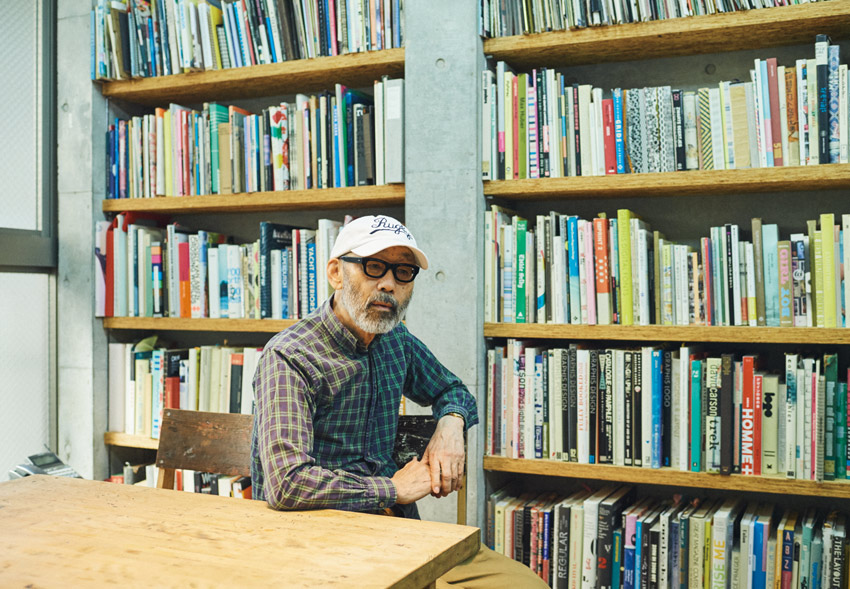-

平凡社を退社するとき、辞める記念にと蔵書の中から1冊だけ 黙って持ち出したのが、この『THE AMERICANS』という写真集です。
When quitting my ex-working place, I sneaked this book, THE AMERICANS, out of the office as a remembrance of my days.
-

後になってロバート・フランクが有名な写真家だと知り、「ああ、自分の目は確かだったんだな」と我ながら感心しました(笑)。
Later I was taught that Robert Frank is a prominent photographer and acknowledged my good foresight (laughs).
-

彼の写真はザラッとした質感と被写体の切り取り方がすごくいい。スペインで撮影された『Valencia 1952』も好きです。
His coarse-grained work and the way he places people for portraits fascinate me. I like “Valencia 1952,” too.
-

ブルース・ウェーバーの『O RIO DE JANEIRO』は、『STUDIO VOICE』のデザインを手掛けたときにすごく影響を受けました。
I was greatly influenced by Bruce Weber’s “O RIO DE JANEIRO”when designing STUDIO VOICE magazine.
-

特に中面の紙質とか色の使い方とか。あまりにも好きすぎて本屋で見つけるたびに買ってしまうので、今も6冊くらい持っています。
I love this book so much that I can’t help myself from buying it again.Now I own about six copies of it.
-

彼については、写真以上にエディットが好きなんですよ。『ALL AMERICAN』シリーズなどもそうですが、造本や編集が本当に上手い。
His way of editing books attracts me more than his photography. He is really good at designing and editing.
-

コム・デ・ギャルソンが1988年から1991年にかけて関係者向けに発行していた全8冊のビジュアルマガジン。
These visual magazines were published by COMME des GARÇONS from 1988 to 1991 to give out to people in the industry.
-

『SIX』というタイトルどおり、読者の“第六感”に訴えかけるような川久保玲さんによる写真のセレクトがとても良くて。
As the title, “SIX,” suggests, the photos selected by Rei Kawakubo seem to stimulate readers’ sixth senses.
-

綴じていないページがある造本も画期的でしたし、雑誌をプロモーションで制作するというアイデアも早いですよね。
The binding of each issue was innovative at the time while promotion via the brand’s own magazine was a visionary idea.
-

篠山紀信さんはポートレートのイメージが強い人だけど、実は何を撮らせても抜群に上手い。これは「日本の食」がテーマ。
Kishin Shinoyama is known for his portrait photos, but his work is always amazing, no matter what his subject is.
-

この『食』という写真集は、写真家としての彼の真っ当な凄さがこれでもかと伝わる1冊で、非常に衝撃を受けました。
His food-themed book,“Syoku,” vividly conveys his outstanding talent as an authentic photographer. Really impressing.
-

川久保玲さんが人に何かをあげるとき、決まってこの本をプレゼントするという話を聞いて、ますますいいなって(笑)。
I grew more fond of this book after having heard that Rei Kawakubo always choose this book as a gift (laughs).
-

横尾忠則さんは学生の頃、一番最初に好きになったアーティスト。同時代の作家の中で圧倒的にすごい人だと思っています。
Tadanori Yokoo is the first artist who attracted me as a student. He is the best artists in his generation, I think.
-

特に『横尾忠則全集』と『横尾忠則グラフィック大全』は、デザイナーになってからも何度見返したか分からないくらい。
I’ve looked at“Yokoo Tadanori Zenshu” and “Yokoo Tadanori Graphic Taizen” countless times after being a designer.
-

横尾さんがアートディレクターだった時期の『流行通信』も、一体どこからこんな発想が!?という刺激的なレイアウトでした。
The design of Ryuko Tsushin magazine was also inspiring during the period when Yokoo worked as the art director.
-

90年代初頭から活動しているNY在住の女性画家、エリザベス・ペイトンの2005年の作品集。出会ったのは20年くらい前。
Elizabeth Payton is a New York based painter who has been active since the 90s. This book was published in 2005.
-

ミュージシャンや自身のボーイフレンドなどを題材にした肖像画で注目を集めた人で、なんとも涼やかな軽さに惹かれました。
She got public attention for her portraits of musicians and her boyfriend. Her light and brisk painting does fascinate me.
-

以前は本の他に版画の作品も2枚所有していたんですが、手放してしまって。今となっては非常に後悔しています。
I once owned two of her block prints along with her books and am now bitterly regretting for parting with those.
-

『Esquire』のバックナンバーは、1933年から60年くらいの号までほぼコンプリート。特に創刊号は2冊キープしています。
I’ve collected almost all the issues of Esquire published between 1933 and 1960 and an extra copy of the first issue.
-

雑誌としても魅力的なのはもちろん、ローレンス・フェローズというイラストレーターが描いた絵が素晴らしいんですよ。
The magazine itself has great appeal, of course, but illustration work by Laurence Fellows are also exceptional.
-

いつの日か『Esquire』のために描かれた、彼のファッションイラストを1冊にまとめた本を作りたいと思っています。
Someday in the future, I want to make a book compiling the fashion illustration he created for Esquire.
-

アメリカの写真家カート・マーカスがカウボーイを撮影した、1985年刊行の『After Barbed Wire: Cowboys of Our Time』。
This book “After Barbed Wire: Cowboys of Our Time” was published in 1985, featuring photography taken by Kurt Markus.
-

昔から西部劇が好きなんですが、この人が撮った写真は荒々しい男たちの世界を捉えながら、不思議と甘いんですよね。
Although his subject in this book is the tough, wild world of cowboys, his photos somehow look sweet and tender.
-

カウボーイたちの服装もいいですね。シャツの着こなし方とか、実はモデルに着せたんじゃないかって思うくらい(笑)。
I like the cowboys’ outfits, too. It’s so cool that I almost can’t believe they are not professional models (laughs).
-

『GENTRY』は、1950年代に発行されたアメリカのライフスタイル誌。誌面に生地を直接貼り付けたり、とても手の込んだ作り。
GENTLY was an American lifestyle magazine. It’s such an elaborate publication, using real fabric in the design.
-

雑誌は今後、この『GENTRY』のような、ハンドメイドで少部数だけ作られるスタイルで生き残っていくんじゃないでしょうか。
In order to survive, the magazine of the future should be handcrafted with a small circulation like GENTLY.
-

古い時代に作られたものですが、単なるコレクターズアイテムというだけでなく、僕はここに“雑誌の未来の姿”を見ています。
Although the magazine was published in the 50s, I see the future of magazine through this publication.
- 1983年にCAPを立ち上げてから青山エリアだけで事務所を5、6回移転したんですが、その度に膨大な量の蔵書を運ぶのが大変で。どこかに基地となるところが欲しいと思って、今から10年前、壁全体が本棚になった、この三階建てのビルを建てました。「全部で何冊くらいあるんですか?」ってよく訊かれますが、正確な数は自分でも分かりません。建築家によれば、総重量は14トンくらいだろうと。本や雑誌は基本、デザインを学ぶための実用書として買います。でも、そのうち自分の中のコレクター魂がムクムクと湧き上がってくるんですよ。例えば、ブルース・ウェーバーの写真集や『Esquire』のバックナンバーなんかは、コンプリート欲に駆られて世界中から探して買い集めました。ただ、本を蒐集することに対する熱意は、随分と冷めてきているように感じています。とにかく青山にあった嶋田洋書がなくなったことがすごくショックで、あれ以来、本屋に行く回数がかなり減りました。あと、紙媒体の将来が今、見えないじゃないですか。そういう状態がここ数年ずっと続いていることも、だんだんと興味が薄れてきた理由のひとつだと思います。それでも古い時代の本や雑誌は、たまに見返すと今よりもデザインや編集が圧倒的に自由で、刺激を受けることも多いですね。今後、本や雑誌は確実に電子化が進み、ウェブメディアに取って代わられるだろうし、デザイナーとしてはそっち方面の勉強をしなくちゃとは思うんですが、正直なところ、いまいち興味が持てなくて。紙の本や雑誌だけが持つ、ページをめくる感触や手触りを含めたフェティッシュな魅力には、やっぱり敵わないですよ。
- Since the establishment of my company, CAP, I had changed our office location quite many times. Whenever moving to a new place, however, we struggled to carry my vast collection of books. And that is the reason I built this three-story building ten years ago, placing built-in bookcases on all the walls. People often ask me how many books I own, but I have no hard numbers. Although I basically buy a book as a design reference, my collecting habit gets out of hand at some point. As for Bruce Weber’s books and the back issues of Esquire magazine, I have purchased them from all over the world to fulfill my passion to collect them all. But my enthusiasm gets weaker these days partly because my favorite bookstore in Aoyama, Shimada Yosho, has closed its doors for good. Another crucial reason for my decreased interest in books is the uncertain future of paper media, I think. When I look at those old books and magazines, however, the design and editorial method of each publication has great freedom. I know I need to learn more about online media as a designer but, to be honest, can’t get myself interested in it. For me, the fetishistic charm of paper media such as the touch and feel of paper is not something substitutable.
Story by Yasushi Fujimoto,
Edit by Daisuke Inoue
Translation by Aya Takatsu

